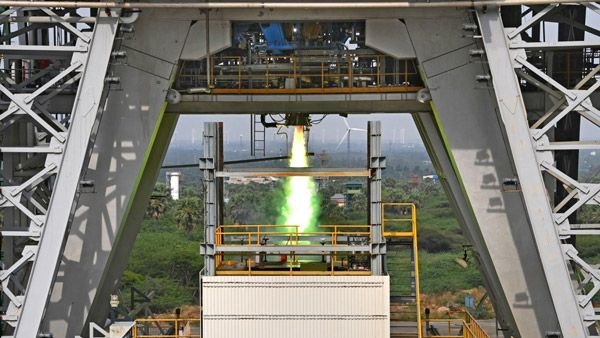ISRO Develops Semi-Cryogenic Engine Using Liquid Oxygen-Kerosene: A Leap in Indian Space Technology
The Indian Space Research Organisation (ISRO) recently made headlines by achieving a significant milestone in space propulsion technology. In a groundbreaking development, ISRO successfully developed a semi-cryogenic engine utilizing a combination of liquid oxygen and kerosene. This achievement marks a monumental leap in India’s space capabilities, opening doors to enhanced payload capacity, cost efficiency, and versatility in space missions.
The semi-cryogenic engine represents a remarkable feat in propulsion technology. By employing a blend of liquid oxygen and kerosene as propellants, ISRO engineers have achieved a balance between performance and affordability. This innovation is poised to revolutionize India’s space program, offering greater flexibility in launching heavier payloads into space while minimizing operational costs.
One of the key advantages of the semi-cryogenic engine lies in its efficiency and reliability. Unlike traditional cryogenic engines that require extremely low temperatures, the semi-cryogenic variant operates at relatively higher temperatures, simplifying the engine’s design and handling requirements. This breakthrough paves the way for more frequent and cost-effective space missions, bolstering India’s position as a leading player in the global space arena.
Moreover, the development of the semi-cryogenic engine underscores ISRO’s commitment to indigenous technological advancements. By harnessing indigenous resources and expertise, ISRO has reduced its dependence on foreign technologies and bolstered India’s self-reliance in critical areas of space exploration. This self-sufficiency not only enhances India’s strategic autonomy but also serves as a testament to the nation’s scientific and engineering prowess.
In addition to its immediate implications for India’s space program, the successful development of the semi-cryogenic engine holds broader significance for the global aerospace industry. As nations worldwide strive to expand their presence in space, the emergence of innovative propulsion technologies like the semi-cryogenic engine offers new possibilities for collaboration and knowledge sharing among spacefaring nations.
In conclusion, ISRO’s achievement in developing a semi-cryogenic engine using liquid oxygen and kerosene marks a watershed moment in India’s space odyssey. This technological breakthrough not only enhances India’s space capabilities but also reaffirms its status as a frontrunner in space exploration. As India continues to push the boundaries of scientific innovation, the journey towards unlocking the mysteries of the cosmos enters a new and exciting chapter.

Why this News is Important:
Advancement in Space Technology:
ISRO’s successful development of a semi-cryogenic engine represents a significant advancement in space propulsion technology. By utilizing a blend of liquid oxygen and kerosene, this innovation enhances India’s ability to launch heavier payloads into space, marking a crucial milestone in the country’s space exploration endeavors.
Cost Efficiency and Versatility:
The use of a semi-cryogenic engine offers cost efficiency and versatility in space missions. By operating at relatively higher temperatures compared to traditional cryogenic engines, ISRO can achieve greater payload capacity while minimizing operational costs, thus optimizing resources for future missions.
Indigenous Technological Advancement:
This achievement underscores India’s commitment to indigenous technological development. By reducing dependence on foreign technologies and leveraging domestic expertise, ISRO strengthens India’s self-reliance in critical areas of space exploration, fostering innovation and strategic autonomy.
Global Implications:
The successful development of the semi-cryogenic engine holds broader significance for the global aerospace industry. As nations worldwide seek to expand their presence in space, the emergence of innovative propulsion technologies like this engine opens new avenues for collaboration and advancement in space exploration.
Strategic Importance:
ISRO’s milestone in developing the semi-cryogenic engine enhances India’s strategic significance in the realm of space exploration. With improved capabilities and self-sufficiency in propulsion technology, India strengthens its position as a key player in shaping the future of space exploration and scientific discovery.
Historical Context:
Background:
India’s journey in space exploration began with the establishment of the Indian Space Research Organisation (ISRO) in 1969. Since then, ISRO has made significant strides in satellite technology, remote sensing, and interplanetary missions, cementing India’s position as a prominent player in the global space arena.
Previous Milestones:
Over the years, ISRO has achieved several milestones, including the successful launch of satellites, lunar missions, and Mars orbiter missions. These accomplishments have garnered international acclaim and reinforced India’s capabilities in space science and technology.
Evolution of Propulsion Technology:
The development of propulsion technology has been a key focus area for ISRO. From solid and liquid propellant engines to more advanced cryogenic engines, ISRO has continuously strived to enhance the efficiency and reliability of its launch vehicles, enabling complex missions and expanding the frontiers of space exploration.
Current Achievement:
Against this backdrop, ISRO’s recent success in developing a semi-cryogenic engine represents a significant leap forward in propulsion technology. This milestone builds upon India’s rich legacy in space exploration and underscores the nation’s commitment to pushing the boundaries of scientific innovation.
Key Takeaways from “ISRO Develops Semi-Cryogenic Engine Using Liquid Oxygen-Kerosene”:
| Serial Number | Key Takeaway |
|---|---|
| 1. | ISRO has successfully developed a semi-cryogenic engine using a blend of liquid oxygen and kerosene. |
| 2. | The semi-cryogenic engine offers enhanced payload capacity, cost efficiency, and versatility in space missions. |
| 3. | This achievement highlights India’s indigenous technological prowess and self-reliance in space exploration. |
| 4. | The development of the semi-cryogenic engine holds broader implications for the global aerospace industry, fostering collaboration and advancement in space exploration. |
| 5. | ISRO’s milestone underscores India’s strategic significance in shaping the future of space exploration and scientific discovery. |
Important FAQs for Students from this News
What is a semi-cryogenic engine?
A semi-cryogenic engine is a type of propulsion system that uses a combination of liquid oxygen and kerosene as propellants. It operates at higher temperatures compared to traditional cryogenic engines, offering a balance between performance and affordability.
What are the advantages of a semi-cryogenic engine?
A semi-cryogenic engine offers enhanced payload capacity, cost efficiency, and versatility in space missions. It simplifies the engine’s design and handling requirements while minimizing operational costs.
How does ISRO’s achievement impact India’s space program?
ISRO’s successful development of a semi-cryogenic engine strengthens India’s space capabilities and reaffirms its status as a leading player in space exploration. It enhances India’s strategic significance and self-reliance in critical areas of space technology.
What are the broader implications of ISRO’s milestone in developing the semi-cryogenic engine?
The development of the semi-cryogenic engine holds broader significance for the global aerospace industry, fostering collaboration and advancement in space exploration among nations worldwide.
How does ISRO’s achievement contribute to India’s technological advancement?
ISRO’s milestone underscores India’s commitment to indigenous technological development and self-sufficiency in critical areas of space exploration, reducing dependence on foreign technologies and fostering innovation.
Some Important Current Affairs Links














